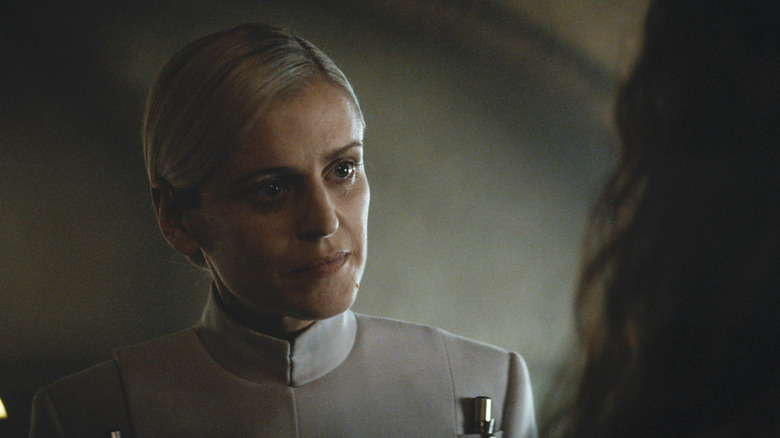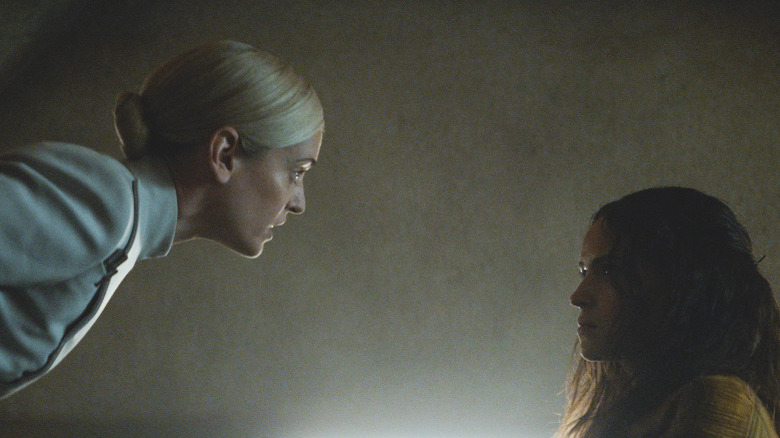Andor Episode 9 Reveals A Staggeringly Evil Form Of Torture By The Empire
This post contains spoilers for "Andor" episode 9.
It's a credit to the creatives on "Andor" that the "Rogue One" prequel-spinoff series has found a way to expose the true depravity of the Galactic Empire while barely shedding even a single drop of blood. That extended to last week's bummer of an episode, which ended with Bix Caleen (Adria Arjona) being captured by the Imperials on Ferrix. The last we saw of her, Cassian's former (?) girlfriend and faithful ally was about to be tortured by Dedra Meero (Denise Gough) and her associates. Exactly what sickening interrogation tactics would the Imperial Security Bureau subject our hero to?
No, Bix didn't have to listen to the digital mixtape that Syril Karn (Kyle Soller) has definitely made to try and impress Dedra, based on the pair's deeply uncomfortable interaction in this week's episode, "Nobody's Listening." Instead, after Dedra makes it clear that she's going to torture Bix before even trying to get any real information out of her, we get a scene where Dedra's associate, the ghoulish Dr. Gorst (Joshua James) explains the mechanics of his new torture methods to Bix. It's staggeringly vile, to say the least.
The Empire, you see, massacred a sentient species native to an Outer Rim moon called Dizon Fray after they fought back against an Imperial refueling center being built there. The sound of them dying was then broadcast and recorded to be used by the Empire to intimidate others. What they found, however, was that the Dizonites' cries left anyone who listened to them in a state of "emotional distress," as Gorst creepily puts it. One particular section composed of dying Dizonite children was especially painful to listen to, so much so that it's an effective tool for torturing people, as poor Bix soon learns.
A disturbing homage to A New Hope
This utterly distressing scene ends with the camera pushing into an extreme closeup of Bix's face as she begins to scream in agony, before quickly cutting to a wide shot and a pan down and up as the door to her holding cell shuts and an Imperial officer strolls away. It's a horrific moment on its own, right down to the smash cut from the sound of Bix crying in anguish to the grinding of machinery in the prison on Narkina 5 where Cassian Andor (Diego Luna) is being held. That it also doubles as an homage to one of the more disturbing scenes in "Star Wars: A New Hope" only adds to its emotional power.
I refer, of course, to the infamous moment where Leia is about to be tortured by Darth Vader aboard the Death Star. The end of this scene is almost visually identical to the one where Bix is being tortured on "Andor," down to the door to Leia's cell slamming shut as the camera pans down and up to follow an Imperial officer walking away. By linking these events visually, "Andor" also calls attention to the ways the Empire refined its brutal tactics over time, reminding us of all the terrible things the Imperials were doing to everyday people off-screen while Luke Skywalker and his friends were saving the day in "A New Hope."
That, perhaps more than anything else, is the key to what makes "Andor" readily the best live-action "Star Wars" series so far. It's a show that goes even further than "Rogue One" in capturing the brutality of war and reminding us of the radical politics at the heart of George Lucas' original "Star Wars" film trilogy.
New episodes of "Andor" premiere Wednesdays on Disney+.

